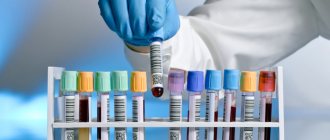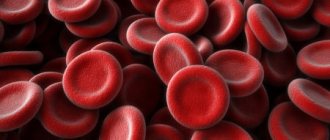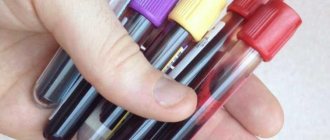Glycated hemoglobin is considered, the norm for women by age, table below.
Glycated hemoglobin is a specific complex of molecules formed as a result of the reaction of combining glucose with hemoglobin of erythrocytes (non-enzymatic Maillard reaction). A referral for laboratory diagnostics is issued by a general practitioner or endocrinologist. Common synonyms: glycohemoglobin, hemoglobin A1c, HbA1c.
The study uses high-performance liquid chromatography under high pressure, the period for obtaining results is no more than 1 day. The cost for private clinics is 500-700 rubles.
Dynamic control
For reference. In addition to early diagnosis of diabetes mellitus, HbA1c indicators make it possible to assess the degree of compensation of carbohydrate metabolism over a certain period of time.
Once the target glucose level is reached, a gradual decrease in HbA1c occurs over four to six weeks. That is, an analysis for glycated hemoglobin allows you to monitor the effectiveness of prescribed therapy and the quality of control of hyperglycemia.
Also, this study is effectively used to assess the risk of complications. If glycated hemoglobin and blood sugar increase (by more than one percent and two mmol/l, respectively), this indicates a high likelihood of developing complications of diabetes.
Attention. Recent studies have shown that reducing HbA1c by 1% can reduce the risk of diabetic retinopathy by 45%, nephropathy by 40% and neuropathy by 35%. . Patients with diabetes should take glycated Hb at least once every three months
Patients with diabetes should take glycated Hb at least once every three months.
Sweet nuances
It is important to distinguish the glycemic profile from the so-called sugar curve (testing glucose tolerance). The differences in these analyzes are fundamental. If blood is taken for a glycemic profile at certain periods of time on an empty stomach and after routine meals, then the sugar curve records the sugar content on an empty stomach and after a special “sweet” load. To do this, after taking the first blood sample, the patient takes 75 grams of sugar (usually sweet tea).
Such tests are often called fasting tests. They, together with the sugar curve, are the most significant in diagnosing diabetes. The glycemic profile is an extremely informative analysis for developing a treatment strategy and monitoring the dynamics of the disease at the stage when the diagnosis has already been made.
Glycated hemoglobin during pregnancy
Glycated hemoglobin during pregnancy is one of the possible tests for monitoring blood sugar. However, this is a bad choice. During pregnancy, it is better not to test glycated hemoglobin, but to check a woman’s blood sugar in other ways. Let's explain why this is so and tell you about better options.
Why is high sugar dangerous in pregnant women? First of all, because the fetus will grow too large, and because of this there will be a difficult birth. The risk for both mother and child increases. Not to mention the long-term adverse consequences for both of them. High blood sugar during pregnancy destroys blood vessels, kidneys, eyesight, etc. The results of this will appear later. Having a baby is half the battle. We need to still have enough health to raise it...
Blood sugar during pregnancy can increase even in women who have not previously complained about their health at all. There are two important nuances here:
- High sugar levels do not cause any symptoms. Usually a woman does not suspect anything, although she is growing a large fetus - a giant weighing 4-4.5 kg.
- Sugar does not rise on an empty stomach, but after meals. After eating, it remains elevated for 1-4 hours. At this time he does his destructive work. On an empty stomach, sugar is usually normal. If your fasting sugar is elevated, then things are really bad.
A fasting blood sugar test is not suitable for pregnant women. Because it usually produces false positives rather than indicating real problems.
Why is a blood test for glycated hemoglobin also not suitable? Because he reacts very late. Glycated hemoglobin increases only after blood sugar has been elevated for 2-3 months. If a woman’s sugar increases, this usually occurs no earlier than the 6th month of pregnancy. In this case, glycated hemoglobin will be elevated only at 8-9 months, shortly before childbirth. If a pregnant woman does not previously control her sugar, then there will be negative consequences for her and the child.
If glycated hemoglobin and fasting blood glucose tests are not suitable, then how to check sugar in pregnant women? Answer: it needs to be checked after meals regularly once every 1-2 weeks. To do this, you can take a 2-hour glucose tolerance test in the laboratory. But this is a long and tedious undertaking. It’s easier to buy an accurate home glucometer and use it to measure your sugar 30, 60 and 120 minutes after meals. If the result is not higher than 6.5 mmol/l, excellent. Within 6.5-7.9 mmol/l - tolerable. From 8.0 mmol/l and above - bad, you need to take measures to reduce sugar.
Follow a low-carb diet, but during pregnancy, eat fruits, carrots and beets every day to avoid ketosis. At the same time, pregnancy is not a reason to allow yourself to overeat on sweets and baked goods. Read more in the articles “Diabetes in pregnant women” and “”.
How to take a glycemic profile?
If you act strictly according to the rules, blood must be taken eight times, starting in the morning until the night portions. The first sampling is in the morning on an empty stomach, all subsequent ones are taken exactly 120 minutes after eating. Night blood samples are taken at 12 o'clock at night and exactly three hours later. For those who do not have diabetes or do not receive insulin as treatment, there is a short version of the glycemic profile test: the first sample in the morning after sleep + three servings after breakfast, lunch and dinner.
Blood is taken using a glucometer in compliance with the mandatory rules:
- Wash your hands with fragrance-free soap.
- Do not treat the skin with alcohol at the injection site.
- No creams or lotions on your hands!
- Keep your hand warm and massage your finger before injecting.
Blood test for glycohemoglobin
It is considered a good alternative to the conventional blood glucose test. Determining glycohemoglobin has many advantages, since the result does not change depending on physical activity, quality of nutrition the day before and emotional state. A one-time glucose test may show increased concentrations, but this does not always indicate problems with sugar metabolism. At the same time, a normal glucose level according to the test does not 100% exclude the absence of the disease.
Testing for glycated hemoglobin is relatively expensive. It is prescribed in the following cases:
- Type 1 diabetes, early diagnosis of type 2 diabetes;
- carbohydrate metabolism disorders in children;
- during pregnancy, if the woman has diabetes;
- gestational diabetes, which occurs in pregnant women;
- tracking the effectiveness of treatment;
- diabetes, in which large amounts of carbohydrates are excreted by the kidneys.
How to take it
According to the standard, laboratory workers are asked to submit material for analysis on an empty stomach, which makes their work easier. To get the exact percentage of glycohemoglobin, it is not necessary to give up breakfast, because the indicator does not characterize the immediate picture, but for the last three months. One meal will not change anything, but it is still worth listening to the requirements of specialists, so as not to waste money on retaking the analysis later.
Depending on the analyzer model, your blood will be taken from a finger or a vein. No special preparation is required for collecting material. In 3-4 days, the results of the study will be ready. If the percentage of glycohemoglobin is within the normal range, analysis should be done once every 1-3 years. If early stage diabetes is detected, the test is carried out every 180 days. If the treatment regimen changes or the patient is unable to independently control sugar levels, the indicator is analyzed once every 3 months.
HbA1c glycated Hb normal in blood
For men, women (and pregnant women too), and children, the norm of glycated hemoglobin in the blood is unified - 4...6%. Anything below or above these boundaries is considered pathological. With an indicator of 6.5% or more, a person is diagnosed with diabetes mellitus. If we analyze the numbers more specifically, we can draw the following conclusions:
- HbA1c within 4...5.7%. Carbohydrate metabolism is normal and the risk of diabetes is very low.
- 5.7...6%. The likelihood of developing diabetes increases. The patient is advised to go on a low-carbohydrate diet.
- 6.1…6.4%. The risk of pathology is very high. It is important for a person to quickly reduce the amount of carbohydrates consumed and switch to a healthy lifestyle.
- 6.5% or more. Preliminary conclusion: diabetes mellitus. The patient is prescribed a number of additional studies.
The norm of glycosylated hemoglobin for diabetics is below 7%. Patients should strive for this indicator, maintain the minimum possible value
In case of diabetes, it is important to follow all the doctor’s recommendations, then the share will drop to 6.5%, which indicates the stage of compensation and a reduced risk of complications. The body's reactions will proceed normally, and your health will become much better.
The norm during pregnancy does not differ from the standard. However, in a woman expecting a baby, the percentage may be lower because fetal development requires energy, which is taken from glucose. Plus, the analysis for glycosylated hemoglobin in healthy pregnant women is not informative until 8-9 months, so it is worth choosing another method of monitoring blood glucose.
Recommendations for recovery in case of deviations from the norm
To restore the desired target level of glycated hemoglobin, you need to:
- choose an insulin administration regimen; in type 1 diabetes, an intensified one is more often used - a long-acting hormone is administered once or twice and a short one before main meals; accurately calculate the dose of “food insulin” depending on the carbohydrate content of foods;
- strictly adhere to the recommendations for nutrition and taking pills for type 2 diabetes;
- exclude from the diet sugar and white flour, foods that quickly increase blood glucose, since they then affect the glycated hemoglobin level (sweet fruits, all types of confectionery, juices and nectars, potatoes, boiled beets and carrots, dried fruits);
- Maintain at least a minimum level of physical activity every day - devote at least 30 minutes to physical activity
Glycated hemoglobin is elevated in diabetes mellitus; it reflects fluctuations in blood glucose over the previous three months. The indicator is needed to monitor the course of the disease; it helps in selecting treatment and preventing complications of diabetes.
Advantages and disadvantages of the analysis performed
The main advantages of this analysis, in comparison with studies on blood sugar levels, as well as with two-hour testing for glucose tolerance, are:
- the impossibility of deliberate distortion of its indicators;
- the speed and accuracy of this study is higher than that of similar ones;
- allows you to detect the presence of diabetes mellitus at the initial stage, when other tests “speak” about the absence of this disease;
- the method of taking blood for testing requires maintaining preanalytical stability (physiological fluid is stored in a test tube until the test is carried out);
- You can donate blood for analysis not only on a full stomach, but also regardless of the time of day;
- allows you to control the quality of recommendations carried out by a diabetic that help reduce sugar;
- the final HbA1C values are not affected by the presence of colds, stress, physical activity, or medications taken (with the exception of medications for the treatment of diabetes);
- universality of the study for all age groups.
Due to the lability of blood sugar, determining its quantitative value using this study is the most complete and reliable, allowing one to detect disorders of glucose metabolism in the early stages. But, at the same time, the analysis for glycosylated hemoglobin has a number of disadvantages:
- the cost of this analysis, in comparison with similar ones, is much higher;
- low regional accessibility of institutions conducting such research;
- if the patient has anemia or hemoglobinopathy, the test result may be unreliable;
- distortion (underestimation) of the final result of the analysis when the patient consumes vitamins C and E in increased dosages;
- the study does not take into account the reduced correlation between the average glucose level and HbA1C, which is characteristic of certain categories of people;
- the result of the analysis may be overestimated if a person has low levels of thyroid hormones.
For early detection of diabetes mellitus and monitoring the quality of drug therapy for the disease, each patient should know what glycosylated hemoglobin is, how to test it correctly, what is the norm for this indicator, and also try to maintain it at an optimal level. This will not only reduce the risk of complications (if the disease is present), but also prevent (if you follow a low-carbohydrate diet) the development of diabetes.
Preparation for testing for diabetes mellitus and glycated hemoglobin
One of the significant advantages of testing for diabetes mellitus by determining glycated hemoglobin is the absence of any preliminary preparation. This is explained by the fact that the indicator reflects the period of the past three months, it is not affected by food intake, time of day, medications and nutrition for at least one week, the level of stress and physical activity, alcohol and smoking.
However, there are conditions in which false results may occur. They are associated with changes in blood composition - an increase or decrease in the number of red blood cells. If there is a decrease (blood loss, iron deficiency, destruction) or accelerated formation (administration of erythropoietin, vitamin B12, iron), blood transfusion, a test is not prescribed. After normalization of total hemoglobin, the percentage of glycated hemoglobin is checked after 1.5-2 months.
There are also diseases that occur with a violation of the structure of the protein of erythrocytes (hemoglobinopathies, most often congenital), and in them it is also impossible to accurately determine glycohemoglobin. In such cases, an analysis of the level of fructosamine in the blood is prescribed.
High HbA1C and sugar connection and consequences
An increase in the presence of sugar in the blood can provoke an increase in the value of glycohemoglobin, which is most typical for type I or II diabetes.
If the percentage reaches 7% or more, the risk of pancreatic diseases immediately increases . This is explained by insufficient glucose tolerance or metabolic disorders.
A woman carrying a child is also obliged to check whether the existing levels correspond to the norm. Otherwise, various anomalies may form - deviations in the process of fetal development, premature birth, a sharp deterioration in the general health of the expectant mother.
If a child is susceptible to high glycated hemoglobin, which is higher than 10%, then trying to quickly bring it down is quite dangerous, as it increases.
If this problem persists for a long time, reducing the level of glycohemoglobin with medication is allowed by no more than 1% every 12 months.
Who needs verification and when?
It should be remembered that only a doctor prescribes a test for GP, as well as interprets its results! This is done:
- In the initial form of glycemia, which is regulated by diet and without medications - every month.
- If sugar is detected in the urine.
- When taking medications that regulate glycemia - every week.
- When taking insulin - a shortened version of the profile - every month.
- For type 1 diabetes - an individual sampling schedule based on the clinical and biochemical landscape of the disease.
- Pregnant women in some cases (see below).
Norm and scope of laboratory test
The norm of glycated hemoglobin in people who do not have diabetes mellitus does not reach 6% and usually ranges from 4 to 5.8% . Differences due to gender, age, and geographic location are somehow not provided for for this indicator, since they simply do not exist. Glycohemoglobin may be slightly increased in children in the first months of life, which is explained by the presence of fetal hemoglobin in their blood (by the age of one year the baby will completely get rid of it), otherwise - no more than 6% for all healthy groups of the population.
Diabetics can expect different digital values of the indicator (up to 12% and higher) , therefore the results are assessed in accordance with generally accepted criteria for determining the regulation of carbohydrate metabolism:
- A hemoglobin Ale value not reaching 6% indicates the absence of violations of the regulatory mechanisms of carbohydrate metabolism;
- An HbAl level of 6–8% indicates good regulatory and compensatory abilities of the body and the effective participation of sugar-lowering drugs in relation to carbohydrate metabolism;
- The proportion of glycated hemoglobin, approaching 9%, indicates that the regulation process is still going satisfactorily and diabetes mellitus is well compensated, but therapy requires revision;
- The 9 - 12% content of hemoglobin that has undergone glycosidation is alarming - these values give reason to believe that the regulatory mechanisms are on the verge of exhaustion, the body cannot cope with the disease, drugs that reduce sugar, it is only partially compensated;
- An increase in glycosylated hemoglobin of more than 12% indicates a lack of regulatory and compensatory abilities - diabetes is not compensated, and therapeutic measures are ineffective.
Obviously, this indicator is increased in diabetes mellitus. It can also indicate how high the risk of developing complications of carbohydrate metabolism disorders (kidney disease, diseases of the organs of vision) is, therefore it is successfully used:
- For diagnosing a latent form of “sugar disease”, and therefore suitable for screening studies;
- In case of long-term monitoring of the course of the disease and the effectiveness of the prescribed therapy;
- To determine the regulation of carbohydrate metabolism and the degree of compensation of the pathological process.
In addition to the listed tasks, the determination of glycohemoglobin serves as a good addition to the glucose load test (sugar curve) when searching for the causes of increased blood glucose in people who are not yet classified as diabetics. In addition, the test is also used when examining for the detection of gestational diabetes mellitus, however, during pregnancy, the analysis of glycated hemoglobin is not a fundamental study. In the case of searching for the hidden course of diabetes mellitus during pregnancy, other methods for determining an increase in the concentration of glucose in the blood, which can trigger the development of the pathological process, are more acceptable.
Interpretation of results
The reasons for the increase are primarily related to impaired carbohydrate metabolism and long-term high glucose in the blood in such cases:
- Diabetes mellitus type 1 (insulin-dependent) - with insufficiency of insulin (pancreatic hormone), the utilization of carbohydrates by the body's cells is impaired, which leads to a long-term increase in concentration.
- Diabetes mellitus type 2 (non-insulin dependent) is associated with impaired glucose utilization with normal insulin production.
- Incorrect treatment of elevated carbohydrate levels leading to prolonged hyperglycemia.
Interpretation of results is complicated by differences in laboratory technology and individual differences in patients - the spread of HbA1c values between two people with the same average blood sugar can be up to 1%.
The table below shows the relationship between glycated hemoglobin and average blood sugar.
| HBA1C (%) | Average blood glucose level (mmol/L) | Average blood glucose level (mg/dL) |
| 4 | 2,6 | 47 |
| 5 | 4,5 | 80 |
| 6 | 6,7 | 120 |
| 7 | 8,3 | 150 |
| 8 | 10,0 | 180 |
| 9 | 11,6 | 210 |
| 10 | 13,3 | 240 |
| 11 | 15,0 | 270 |
| 12 | 16,7 | 300 |
The analysis was developed on the basis that the process of hematopoiesis and the replacement of red blood cells proceed normally, so the results may be distorted due to severe bleeding, as well as in hemolytic anemia (for example, in sickle cell disease). In this case, an alternative may be to measure the level of fructosamine, a glycosylated protein in the blood plasma that serves as an indicator of glycemia for a period of 2-3 weeks before the measurement.
Analysis that can be taken at any time of the day or night
The biological material for the study is blood from a vein in the amount of 3 ml.
Taking the test is very easy because:
- It does not require coming to the laboratory on an empty stomach or any other restrictions, because information about the glucose level in the blood has not been accumulated in one day and is quite deeply and securely hidden.
- Having firmly bound to hemoglobin, sugar will not leave the blood pigment until the latter is destroyed, so the patient definitely has a month to think about it;
- Doctors have even more time, because they mainly focus on 60 days. This period follows from the lifespan of red blood cells, taking into account the fact that red cells of different ages circulate in the bloodstream.
Diabetics have to take a test for glycated hemoglobin every 3 months so that the doctor knows the situation, prescribes the necessary medications in a timely manner or makes adjustments to the treatment regimen used. If the test results are in doubt, which happens in patients with some blood pathology (hemolytic anemia), you should turn to alternative methods of laboratory diagnosis of diabetes, for example, a study of glycosylated albumin (fructosamine). Fructosamine reflects the state of carbohydrate metabolism in a given patient during the last 2-3 weeks before the analysis. Less, of course, than glycated hemoglobin (2 months), but still... You’ll just have to donate blood for testing more often.
Indications for testing
If necessary, the level of glycosylated hemoglobin is determined in children, adolescents, as well as adults, including pregnant women:
Expert opinion
Guseva Yulia Alexandrova
Specialized endocrinologist
One of the main advantages of the method is that it allows you to identify dangerous endocrine disorders at their earliest stages.
Summary of Glycated Hemoglobin
Here are a few more points that I would like to repeat:
- HbA1c should be determined once every three months, no more often, but no less often. Having assessed the result, take appropriate measures. This should not be a test that you take for show or for the doctor. First of all, you need this analysis.
- Determining HbA1c does not in any way replace measuring sugar levels with a regular glucometer. Remember the joke, if anyone doesn’t know, I’ll write it at the end of the article.
- Even if you have an ideal HbA1c, but there are daily fluctuations in blood sugar of more than 5 mmol/l, this cannot in any way protect you from the development of complications. This is a proven fact. It has been proven that, given the same indicator, those who have had or have such fluctuations are most susceptible to complications.
- Long-term elevated HbA1c levels should be reduced gradually, 1% per year.
- Don't chase the ideal, strive for your target. What is given to the young can be harmful to the elderly.
And that's all for me. Target glycated hemoglobin for you! If you haven’t read it yet, I recommend you the article “Can diabetes be completely cured?”
How do you like the article? Click the social buttons. networks right below the article to share with friends and family. I advise you to subscribe to updates to receive only high-quality and useful articles on diabetes and more. Much more will be said and written.
With warmth and care, endocrinologist Lebedeva Dilyara Ilgizovna
Glucometers: requirements, features
Since sampling and measurements must always be taken with the same glucometer (calibrations may vary), ease of use and accuracy of tests are absolute and mandatory requirements. Additional advantages of glucometers when choosing:
- Memory (saving previous data).
- Display size and compactness.
- The volume of a drop of blood required for analysis (the smaller the better).
Normal for healthy people and diabetics
The rate of hemoglobin exposed to sugar is the same for both sexes. The sugar level increases slightly with age: the upper limit increases in old age from 5.9 to 6.7 mmol/l. With a stably maintained first value, the GG will be about 5.2%. If sugar is 6.7, blood hemoglobin will be slightly less than 6. In any case, a healthy person should not have a result greater than 6%.
To decipher the analysis, use the following criteria:
| GG level | Interpretation of the result | a brief description of |
| 4 < Hb < 5.9 | norm | The body absorbs sugar well, removes it from the blood in a timely manner, and diabetes is not a threat in the near future. |
| 6 < Hb < 6.4 | prediabetes | The first metabolic disorders require an appointment with an endocrinologist. Without treatment, 50% of people with this test result will develop diabetes in the coming years. |
| Hb ≥ 6.5 | diabetes | It is recommended to test your sugar on an empty stomach for a final diagnosis. Additional research is not required if the level is significantly higher than 6.5% and there are symptoms of diabetes. |
The norm for diabetes is slightly higher than for healthy people. This is due to the risk of hypoglycemia, which increases with a decrease in the proportion of GG. It is dangerous to the brain and can lead to hypoglycemic coma. For people who experience frequent hypoglycemia due to diabetes or whose body is prone to rapid drops in sugar, the rate of glycosylated hemoglobin is even higher.
There are no strict requirements for elderly diabetics. Chronic complications of diabetes accumulate over years. When the time to onset of complications exceeds life expectancy (average life length), diabetes may be less strictly controlled than at a young age.
For young people, the target level of GG is the lowest; they will live a long life and remain active and productive for all time. Sugar levels in this category of the population should be as close as possible to the norms of healthy people.
| Diabetic health status | Age, years | ||
| Young, under 44 | Medium, up to 60 | Elderly, up to 75 | |
| Rare, mild hypoglycemia, stage 1-2 diabetes, good disease control. | 6,5 | 7 | 7,5 |
| Frequent decreases in sugar or a tendency to severe hypoglycemia, stage 3-4 diabetes - with clear signs of complications. | 7 | 7,5 | 8 |
A rapid decrease in glycated hemoglobin from consistently high values (more than 10%) to normal can be dangerous for the retina of the eye, which has adapted to high sugar over many years. To prevent vision deterioration, patients are recommended to reduce GG gradually, 1% per year.
Don’t think that just 1% is insignificant. According to research, such a reduction can reduce the risk by 35%, neurological changes by 30%, and reduce the likelihood of a heart attack by 18%.
Cost of analysis
The price of conducting a study of biomaterial depends greatly on the city, the method of study used, as well as the specific laboratory.
The minimum cost of the service in medical institutions of the country is 400 rubles, the maximum is about 1 thousand rubles.
Due to its higher cost, glycosylated hemoglobin level testing is much less commonly used than a conventional blood sugar test. However, it is worth understanding that in terms of information content, as well as the ability to “show” diabetes in the early stages, the method has no equal.
What does glycated hemoglobin show in the blood?
Green color means normal GG values. Yellow color - shows satisfactory GG indicators. Red color indicates high GG values that require adjustment and revision of current therapy.
Normal indicators for women during pregnancy should not be below a certain minimum. Low sugar in the mother leads to delayed mental development of the baby, and with a high degree of probability predicts difficulties with the behavior and health of the child.
If the mother's sugar level is normal, the test is prescribed once - at 10-12 weeks of pregnancy. The target glycohemoglobin level should correspond to the age group of the expectant mother.
- at a young age, hba1c glycated hb norm is less than 6.5%
- in middle age this parameter should be no more than 7%
- the norm of glycated hemoglobin in elderly pregnant women is less than 7.5%
Features of test results in children
The hba1c test is also necessary for children under 14 years of age for certain symptoms. This analysis is prescribed when the rate is from 7 to 10%, which is significantly higher than the norm. What does this mean for the child?
Glycemic control in pregnant women
Pregnant women can develop a special type of diabetes – gestational diabetes. Most often, such diabetes goes away after childbirth. But, unfortunately, there are increasingly cases where gestational diabetes in pregnant women without proper control and treatment turns into type 2 diabetes. The main culprit is the placenta, which secretes insulin-resistant hormones. This hormonal struggle for power manifests itself most clearly between 28 and 36 weeks, during which time the glycemic profile during pregnancy is prescribed.
Sometimes the sugar content in the blood or urine of pregnant women exceeds the norm. If these cases are isolated, there is no need to worry - this is the physiology of pregnant women “dancing”. If increased glycemia or glycosuria (sugar in the urine) is observed more than twice and on an empty stomach, you can think about pregnancy diabetes and order a glycemic profile test. Without hesitation and immediately you need to prescribe such an analysis in the following cases:
- overweight or obese pregnant woman;
- diabetes in first-degree relatives;
- ovarian diseases;
- the age of the pregnant woman is over 30 years.
Glycated hemoglobin is normal
Glycated (or glycosylated, HbA1c) hemoglobin is a biochemical indicator that shows the average blood sugar level over the past three months. Hemoglobin is a protein found in red blood cells. When such proteins are exposed to glucose for a long time, they bind into a compound called glycated hemoglobin.
The indicator of glycated hemoglobin is determined as a percentage of the total amount of hemoglobin in the blood. The higher the sugar level, the more hemoglobin is bound, and the higher this indicator. Moreover, taking into account the fact that hemoglobin does not bind immediately, the analysis does not show the current blood sugar level, but the average value over several months, and serves as one of the most common methods for diagnosing diabetes mellitus and pre-diabetic conditions.
Norm of glycated hemoglobin in the blood
Normal values for a healthy person are considered to be in the range of 4 to 6%, values in the range from 6.5 to 7.5% may indicate a risk of developing diabetes or iron deficiency in the body, and values above 7.5% usually indicate the presence of diabetes mellitus .
What influences the result?
Some medications have an effect on red blood cells, which in turn is reflected in the results of a blood test for glycosylated hemoglobin - we get an unreliable, false result.
So, they increase the level of this indicator:
- aspirin in large doses;
- opiates taken over a long period of time.
In addition, chronic renal failure, systematic alcohol abuse, and hyperbilirubinemia contribute to the increase.
Reduce the content of glycated hemoglobin in the blood:
- iron supplements;
- erythropoietin;
- vitamins C, E and B12;
- dapsone;
- ribavirin;
- drugs used to treat HIV.
This can also occur with chronic liver diseases, rheumatoid arthritis, and increased levels of triglycerides in the blood.
How to normalize glycated hemoglobin
To lower or increase blood glucose levels, returning them to normal values, you must strictly follow the endocrinologist's instructions. In addition to conservative treatment, lifestyle changes will come to the rescue: a suitable diet, exercise and
Proper nutrition
For type 2 diabetes and elevated glycohemoglobin levels, treatment table No. 9 is recommended for the patient. The diet limits the presence of sugar-containing foods in the diet, replacing them with glucose-suppressing ones. White bread, pasta and potatoes, sweet drinks and sugar are prohibited. Vegetables, fats and meat products are allowed.
If your glycohemoglobin level is elevated, you need to eat more meat.
With low glycohemoglobin, you need to consume more proteins and complex carbohydrates. Nuts and legumes, vegetables, whole grain bread, various fruits, lean meats and dairy products are recommended. Avoid caffeine, carbonated drinks and high fat foods.
If you eat right, your glucose levels will quickly return to normal.
Physical exercise
If your glucose level is high, you need to include moderate physical activity in your daily routine, which will help you burn more glucose and keep your body in good shape. Walking and slow running, swimming, cycling, and ball games are acceptable. Extreme sports should be avoided.
If the level of glycohemoglobin is reduced, you should refrain from sports: even small loads in this state can harm the body.
Jogging and exercise are helpful for high glucose levels
Emotional condition
A short-term increase in blood glucose levels can occur due to stress, increased anxiety, frustration, fear and depression. Taking antidepressants can also affect the amount of sugar.
Frequent stress can increase blood glucose levels
To normalize your emotional state and solve psychological problems that provoke an increase in blood sugar, you should consult a psychologist.
Glycohemoglobin analysis is an effective way to determine the amount of sugar. It is much more convenient than standard methods because it does not depend on external factors and displays the average glucose level over a long period of time.
How to get tested for glycosylated hemoglobin?
A person does not have to undergo any special training.
It is not at all necessary to come to the laboratory on an empty stomach - you can have breakfast before taking blood.
Physical activity, stress, previous illnesses, etc. also do not have a significant impact on the level of the analyzed indicator. The patient only needs one thing: to visit the laboratory at any convenient time.
The sample is taken from a vein or finger (this depends on which analyzer is installed in a particular medical institution). The analysis takes three to four days to prepare.
Expert opinion
Guseva Yulia Alexandrova
Specialized endocrinologist
Thyroid diseases and iron deficiency anemia diagnosed in a person may distort the results of the test.
Reasons for deviation of the indicator from the norm
The ideal level of glycohemoglobin is in the range of 4.6-5.7% .
This HBA1C value does not allow the glucose level to exceed the permissible values, which indicates the presence of a minimal risk of the formation of any pathologies. Anyone should take steps to achieve optimal levels.
True, sometimes situations arise when the deviations presented below are observed. When glycated hemoglobin increases over a long period of time, the patient is usually diagnosed with diabetes.
This serious illness requires the initiation of an immediate course of therapy in compliance with the prescribed diet.
But sometimes a slightly increased glycohemoglobin can appear due to:
- lack of iron;
- excessive consumption of alcoholic beverages over a long period of time;
- renal failure;
- poisoning of the body with substances of a chemical nature;
- surgery leading to the removal of the spleen.
In turn, low values of glycohemoglobin density usually appear when:
- blood transfusion;
- blood loss as a result of injury, surgery, abortion, difficult childbirth;
- hemolytic disease.
A course of therapeutic support helps here, which after a short time normalizes the value of glycated hemoglobin.
Deviations from standard glycohemoglobin levels are also sometimes observed, which is explained by a lack of iron in the body.
Reasons for lowering the indicator below the standard
If a biochemical analysis showed that glycohemoglobin does not reach the normal level, what does this mean?
We list the possible reasons for the indicator to drop below the standard:
- hypoglycemia;
- recent blood loss;
- serious malfunctions of the pancreas;
- liver or kidney failure;
- premature destruction of red blood cells in the body.
A decrease in the level of glycated hemoglobin in the body has pronounced symptoms. The patient suffers from drowsiness, decreased vision, severe fatigue, irritability and fainting.
Reasons for increase and decrease
The cause of a decrease in glycated hemoglobin may be hypoglycemia (low blood glucose levels). Insulinoma is also a provoking factor. This is a formation in the pancreas that produces too much insulin. At the same time, the sugar content decreases, which causes hypoglycemia.
The following reasons for reducing glycated sugar are no less common:
- rare hereditary diseases;
- poor diet with low carbohydrate intake;
- overdose of drugs that lower blood sugar;
- adrenal insufficiency;
- excessive physical activity.
An increase in level is a sign of hyperglycemia. This condition does not always indicate pancreatic disease. Values from 6.1 to 7% are more likely to indicate prediabetes, impaired carbohydrate tolerance, or increased fasting glucose.
It is recommended to monitor the content of glycated hemoglobin once a year:
- persons over 40 years old
- with a hereditary predisposition to type 2 diabetes mellitus
- overweight (body mass index 25-29) or obese (body mass index more than 30)
The materials on this blog cannot be used for self-medication. Taking any medication without a doctor's prescription is dangerous to your health. Only a doctor can recommend something to you, make diagnoses and prescribe treatment in a personal meeting. I can only share my opinion, which is based on scientific research and my own experience.
*******************************************
anti-ageing health constants health control
Glycated hemoglobin targets
Not every patient needs to lower glycated hemoglobin to the levels of a healthy person. There are some patients for whom it is better if the indicator is slightly increased. These include older people and patients who have developed associated complications. Glycated hemoglobin, the norm for diabetes mellitus in this case should be about 8%.
The need for this level is determined by the fact that in the case of low levels of this analysis, the risks of developing hypoglycemic conditions, which are very dangerous for the patient in old age, may increase. Young people require stricter control and should aim for the 6.5% level to prevent the development of complications of this disease.
If the analysis shows high numbers (10% or higher), then it is recommended to reconsider your habits and lifestyle and diabetes treatment. However, it should be remembered that there is no need to strive for a sharp reduction in this indicator, but, on the contrary, do it slowly, by 1-1.5% per year. This is explained by the fact that the body of such a person is already accustomed to high glycemic levels and complications have already begun to develop in small vessels (eyes and kidneys).
With a sharp decrease in glucose, a vascular crisis can develop, which, in turn, can lead to a sharp decrease in kidney function or loss of vision. This fact is scientifically confirmed, as well as the fact that fluctuations in glycemic levels up to 5 mmol/l do not cause a sharp development of vascular complications.
This is why adequate control of glycosylated hemoglobin along with the glycemic profile is important for patients with both types of diabetes, because in the absence of proper control, a person simply does not know how much his sugar level rises and falls.
Glycosylated hemoglobin is increased, what does this mean?
Glycosylated hemoglobin is a very important laboratory indicator and such a test must be taken for those people whose doctor suspects diabetes mellitus. But after taking the test, it turned out that glycosylated hemoglobin was increased and what does this mean?
An elevated hemoglobin level indicates that a person has diabetes. Sometimes this may indicate a lack of iron in the body.
You need to know the following:
- an increased level of glycosylated hemoglobin from 5.5 and more than 7 indicates symptoms of type 2 diabetes. And if the hemoglobin level is increased from 6.5 to 9.5, then diabetes is likely. In this case, blood from a finger taken for sugar may be normal,
- Be sure to visit an endocrinologist. Diabetes mellitus is a complex disease that, if treated improperly or without treatment at all, can lead to many complications. The patient's kidneys and cardiovascular system are affected, and his vision decreases. Therefore, you need to try to ensure that no complications arise and now you need to constantly maintain your blood sugar level, and an endocrinologist will tell you how to do this.
- glycated hemoglobin should be measured every three months. Based on the analysis results, appropriate measures are taken. Long-term elevated hemoglobin should be reduced gradually, especially for young people when they have had it elevated for a long time. If you reduce it sharply, it can have a negative effect on your vision. The best rate is a decrease of one percent per year,
- Don't forget about your age. What is considered normal for young people may be a reduced rate for older people. If at a young age an indicator of 6.5 is considered to be such that it does not cause any special risks, then for old people an indicator of 7.5 is considered normal.











